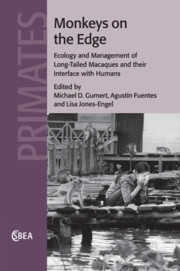Book contents
- Frontmatter
- Contents
- List of contributors
- Foreword
- Preface
- Acknowledgements
- Part I The status and distribution of long-tailed macaques
- Part II The human–macaque interface
- Part III Ethnophoresy of long-tailed macaques
- Part IV Comparisons with rhesus macaques
- Part V Understanding and managing the human–macaque interface
- 12 Developing sustainable human–macaque communities
- 13 Future directions for research and conservation of long-tailed macaque populations
- Index
- References
12 - Developing sustainable human–macaque communities
from Part V - Understanding and managing the human–macaque interface
Published online by Cambridge University Press: 16 May 2011
- Frontmatter
- Contents
- List of contributors
- Foreword
- Preface
- Acknowledgements
- Part I The status and distribution of long-tailed macaques
- Part II The human–macaque interface
- Part III Ethnophoresy of long-tailed macaques
- Part IV Comparisons with rhesus macaques
- Part V Understanding and managing the human–macaque interface
- 12 Developing sustainable human–macaque communities
- 13 Future directions for research and conservation of long-tailed macaque populations
- Index
- References
Summary
Introduction
A variety of factors make the management of free-ranging macaque populations challenging, both for communities and policy makers. The objective of this chapter is to discuss management options that promote sustainable coexistence of species. Well-conceived strategies will support the economic and social goals of humans, the conservation of macaque populations, and the health of both human and macaque populations.
Potential goals for managing the human-macaque interface
In any place where humans and macaques exist in proximity, individuals or groups will have specific interests, goals or objectives concerning the management of the human–macaque interface. Frequently, the interests of one group or individual will be in conflict with others, making it difficult to reach consensus on implementing any specific management practice. For example, in communities where macaques are a tourist attraction, tour guides and food vendors may perceive the recreational provisioning of food to macaques as desirable, as it is popular with tourists and often economically rewarding for vendors. Conservationists and public health officials, however, may seek to prevent tourists from feeding monkeys in order to reduce the human impact on macaque populations and reduce the risk of bi-directional transmission of infectious agents. Primatologists are often engaged in studying synanthropic macaque populations, and these researchers also have specific interests and goals regarding management of conflict. In general, we place a high value on supporting the endurance and health of macaque populations, increasing the public appreciation of macaques, and facilitating a sustainable intra-specific relationship by reducing interspecies conflict.
- Type
- Chapter
- Information
- Monkeys on the EdgeEcology and Management of Long-Tailed Macaques and their Interface with Humans, pp. 295 - 327Publisher: Cambridge University PressPrint publication year: 2011
References
- 13
- Cited by



